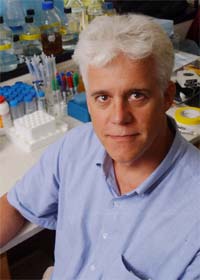UT Southwestern researchers find protein that both instigates, inhibits heart growth in mice

Dr. Eric Olson and a team of researchers have discovered a protein that continuously regulates heart development in mice from the embryonic stage to adulthood. <br>
Researchers at UT Southwestern Medical Center at Dallas have discovered a protein that regulates growth and development of the heart from its fetal stage to adulthood.
Findings published in today’s edition of Cell report that the protein, named Homeodomain-Only Protein (HOP) by the researchers, is active in controlling heart growth at various stages of development in mice. Dr. Eric Olson, chairman of molecular biology at UT Southwestern and the study’s principal investigator, said the team set out to find proteins unique to the heart and study their functions. After they identified HOP, they bred mice that were genetically unable to produce the protein, with dramatic results.
“We created knockout mice lacking the gene to produce this protein, and they fell into two classes – they either died as embryos because their hearts didn’t grow, or they survived to adulthood with too many cardiac muscle cells,” said Olson, director of the Nancy B. and Jake L. Hamon Center for Basic Research in Cancer and the Nearburg Family Center for Basic Research in Pediatric Oncology.
“Understanding the mechanisms that regulate growth of heart cells has important implications for eventual therapies directed toward repairing the damaged heart,” Olson said.
Observed problems during the fetal stages of the mutant mice included numerous ruptures of the ventricular walls, thin heart chamber layers and blood in the fibrous tissue surrounding the heart. After birth, there were elevations – as much as 19-fold – in the number of growing cardiac muscle cells in mutant compared to wild-type mice, and gene profiling showed that 179 genes had elevated expression and 90 genes had reduced expression.
The researchers believe that HOP works by controlling levels of serum response factor (SRF), a gene-activating protein, during heart development. SRF and three sibling proteins form a group called the MADS-box, and those proteins trigger genetic activity that produces a number of organs and systems. In the case of heart development, SRF controls the number and types of cells produced, and HOP controls the activity of SRF. Without HOP, SRF can’t properly balance heart-cell proliferation and differentiation, resulting in either an underdeveloped or overdeveloped heart.
“There has to be a finely tuned balance of proliferation and differentiation of cardiac cells for normal heart development,” said Olson. “There’s a lot of interest in regulating the cardiac-cell cycle because the heart can’t repair itself; it can’t regenerate cells efficiently.”
While Olson and his team believe the identification of HOP and its role in heart development is important, they also believe they’ve only uncovered a small fragment of the tableau.
“We need to figure out how to regulate HOP; obviously, other signals and proteins have to be involved to dictate that,” Olson said. “But HOP is an important component of a mechanism that regulates heart growth.”
San Diego-based Collateral Therapeutics Inc., a company working to develop genetic treatments for heart ailments, already has licensed the research in order to explore drug-development possibilities.
Media Contact
More Information:
http://www.swmed.edu/All latest news from the category: Life Sciences and Chemistry
Articles and reports from the Life Sciences and chemistry area deal with applied and basic research into modern biology, chemistry and human medicine.
Valuable information can be found on a range of life sciences fields including bacteriology, biochemistry, bionics, bioinformatics, biophysics, biotechnology, genetics, geobotany, human biology, marine biology, microbiology, molecular biology, cellular biology, zoology, bioinorganic chemistry, microchemistry and environmental chemistry.
Newest articles

Superradiant atoms could push the boundaries of how precisely time can be measured
Superradiant atoms can help us measure time more precisely than ever. In a new study, researchers from the University of Copenhagen present a new method for measuring the time interval,…

Ion thermoelectric conversion devices for near room temperature
The electrode sheet of the thermoelectric device consists of ionic hydrogel, which is sandwiched between the electrodes to form, and the Prussian blue on the electrode undergoes a redox reaction…

Zap Energy achieves 37-million-degree temperatures in a compact device
New publication reports record electron temperatures for a small-scale, sheared-flow-stabilized Z-pinch fusion device. In the nine decades since humans first produced fusion reactions, only a few fusion technologies have demonstrated…





















